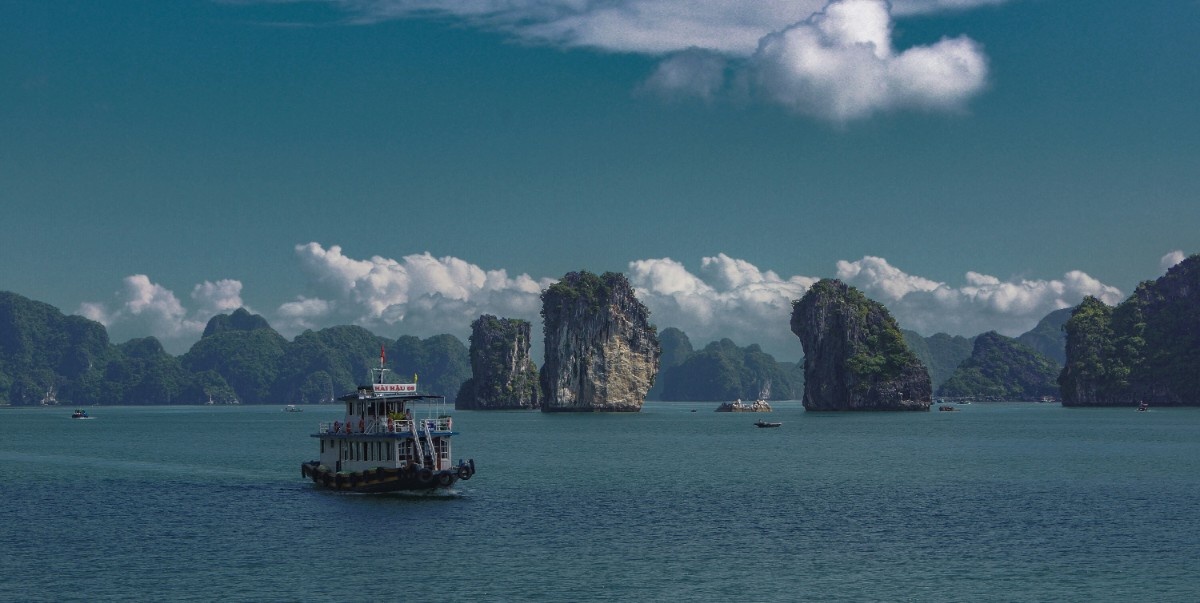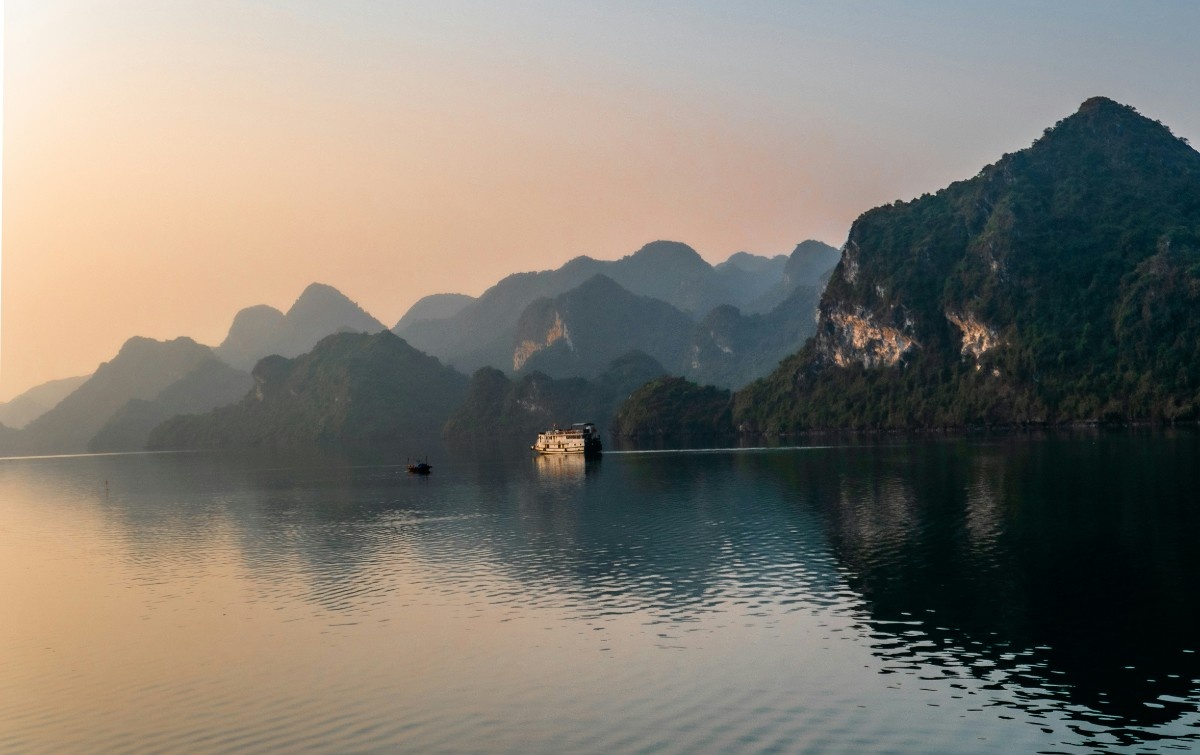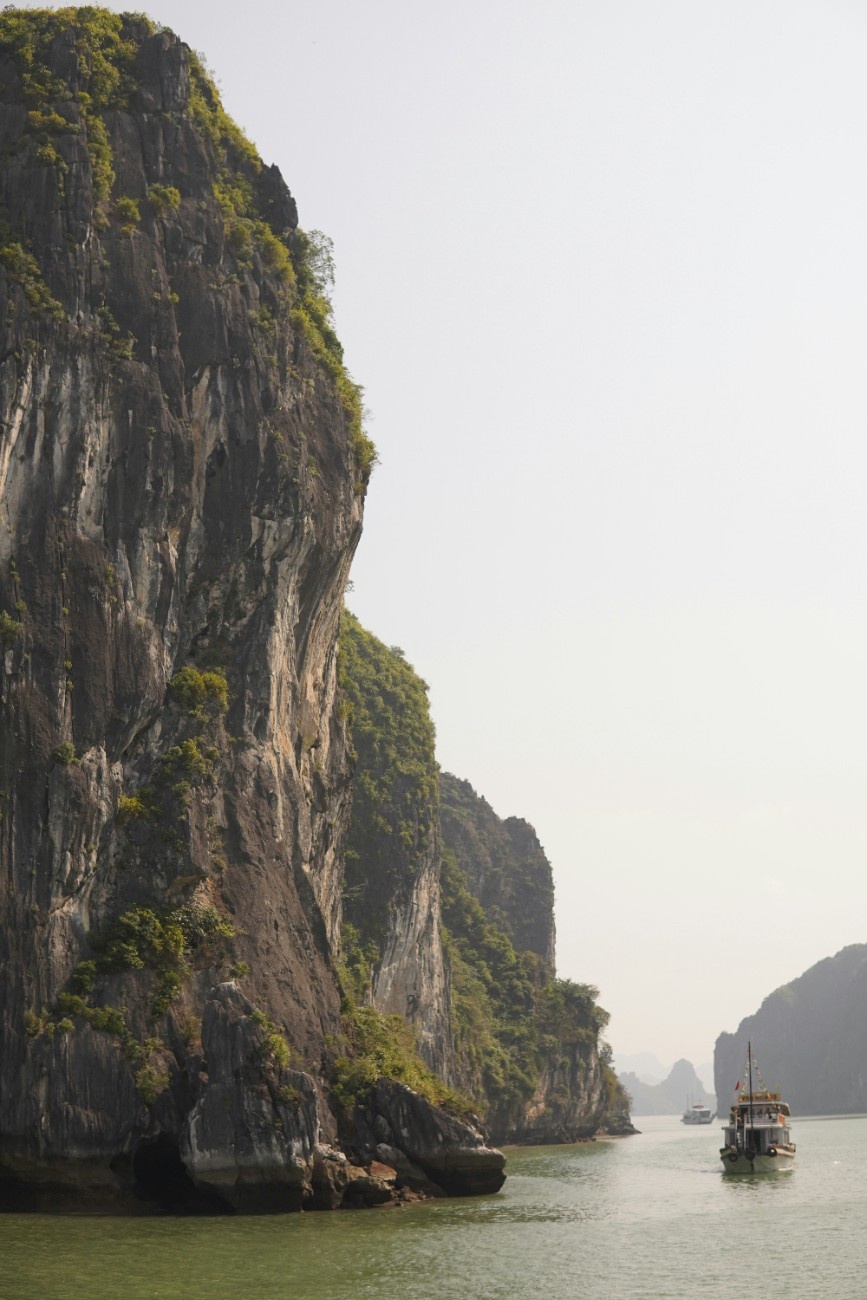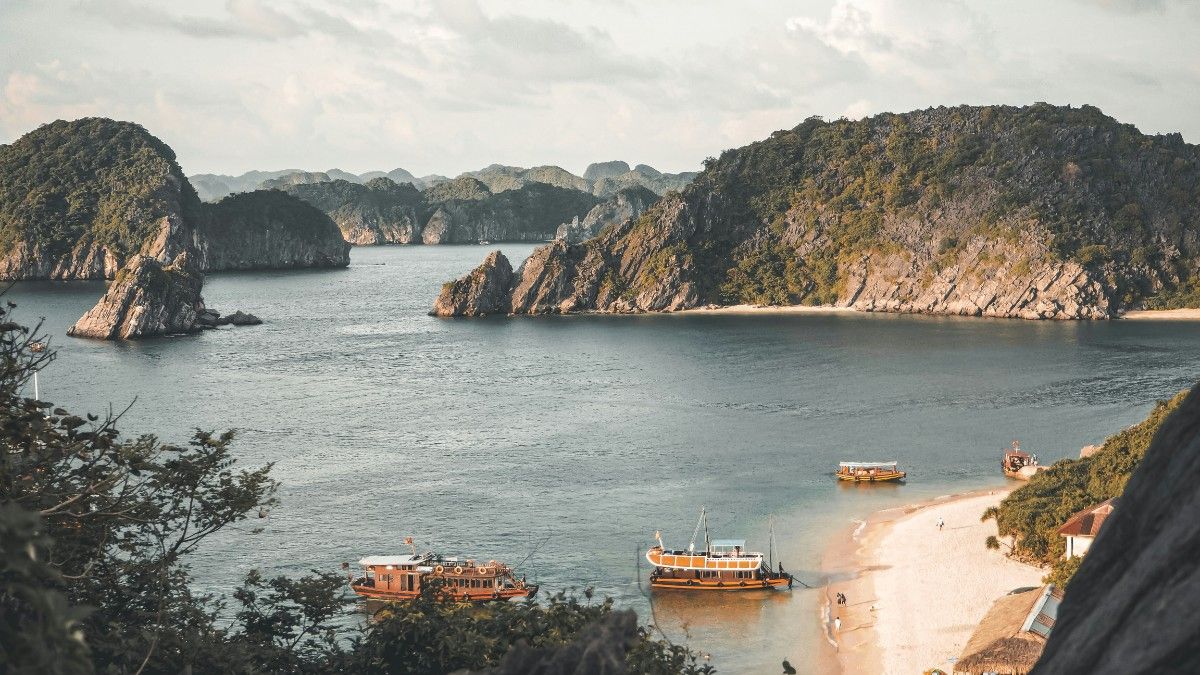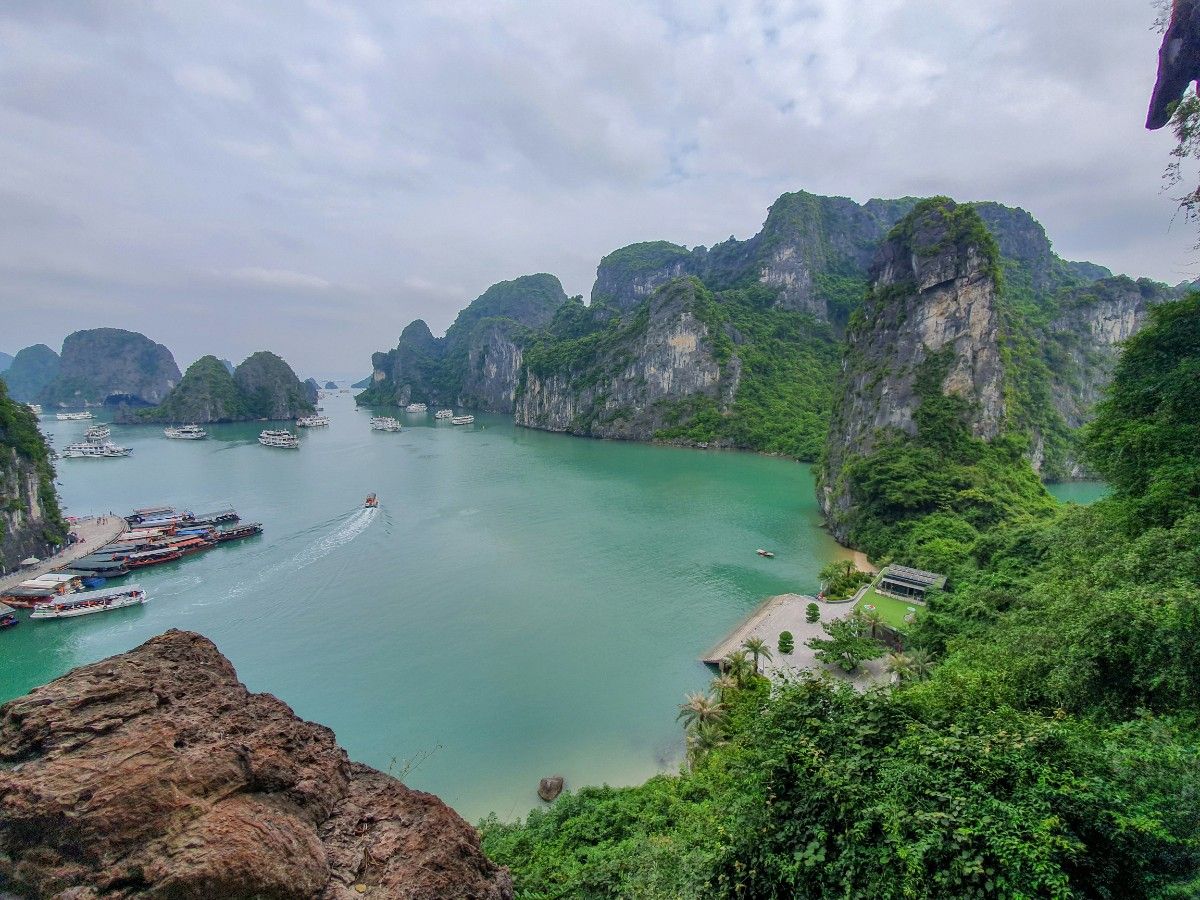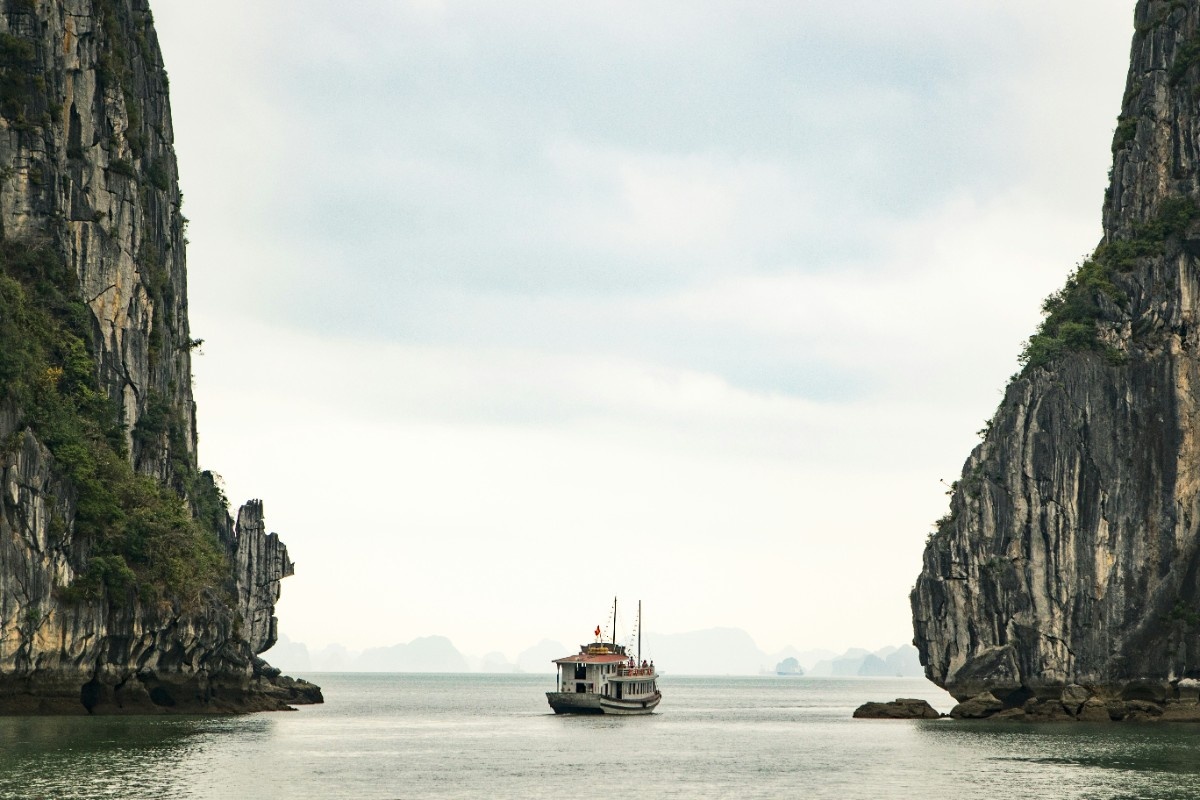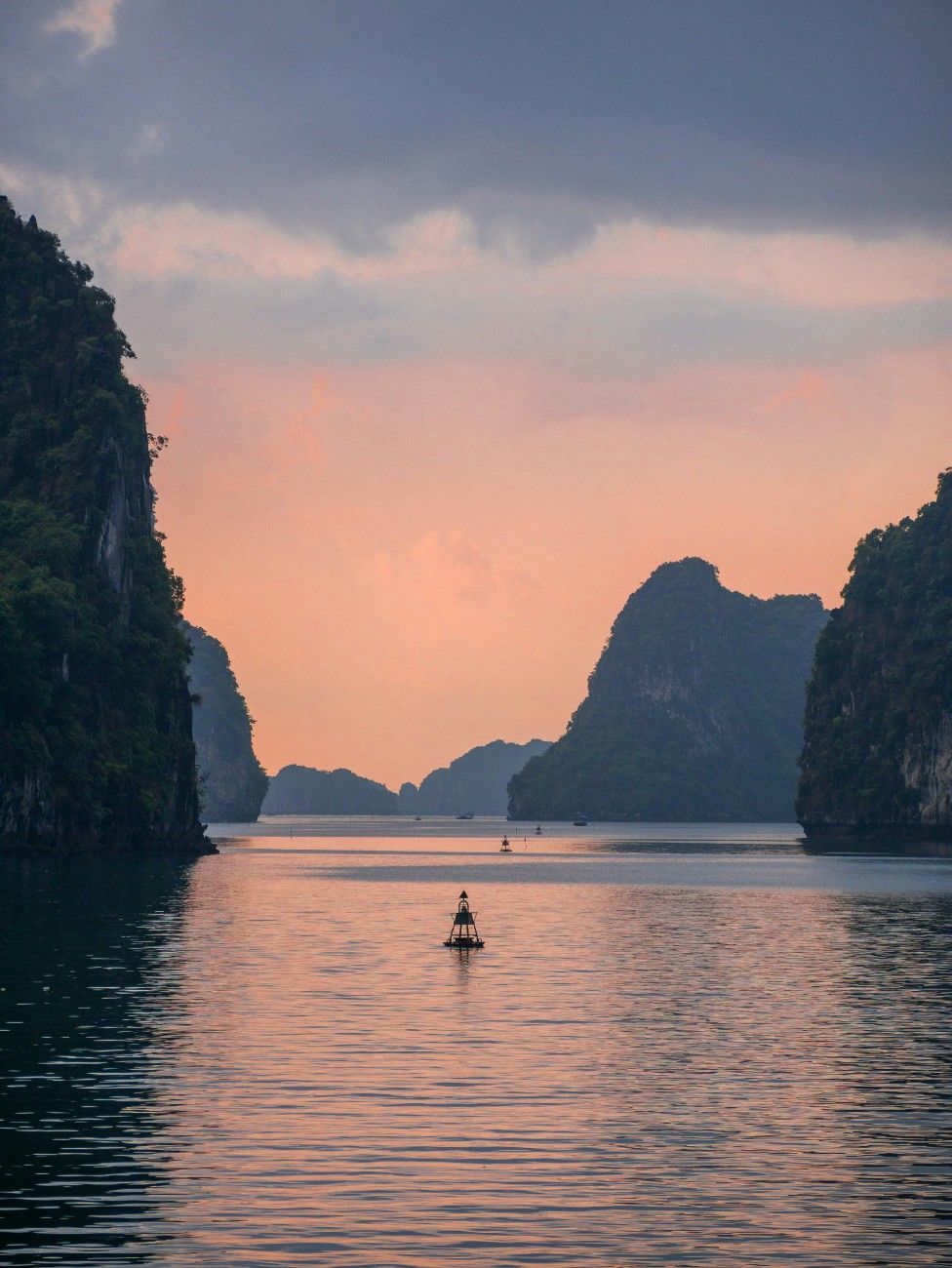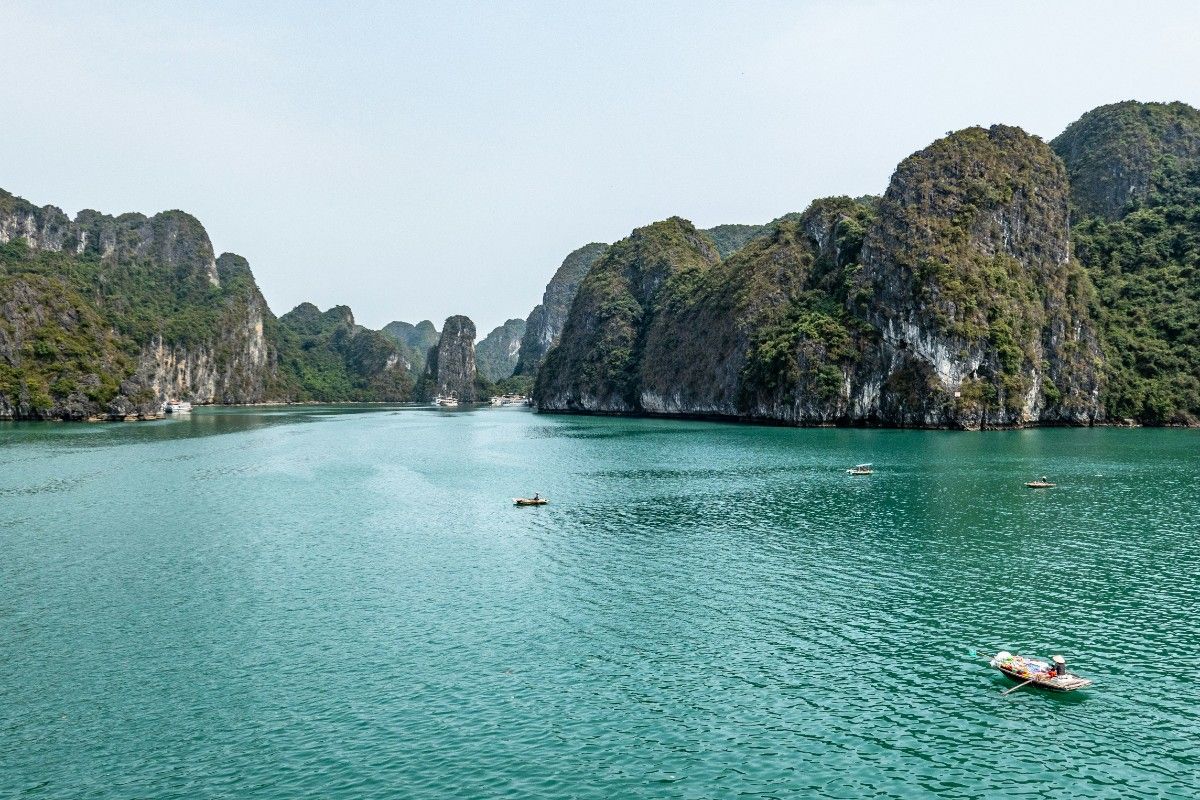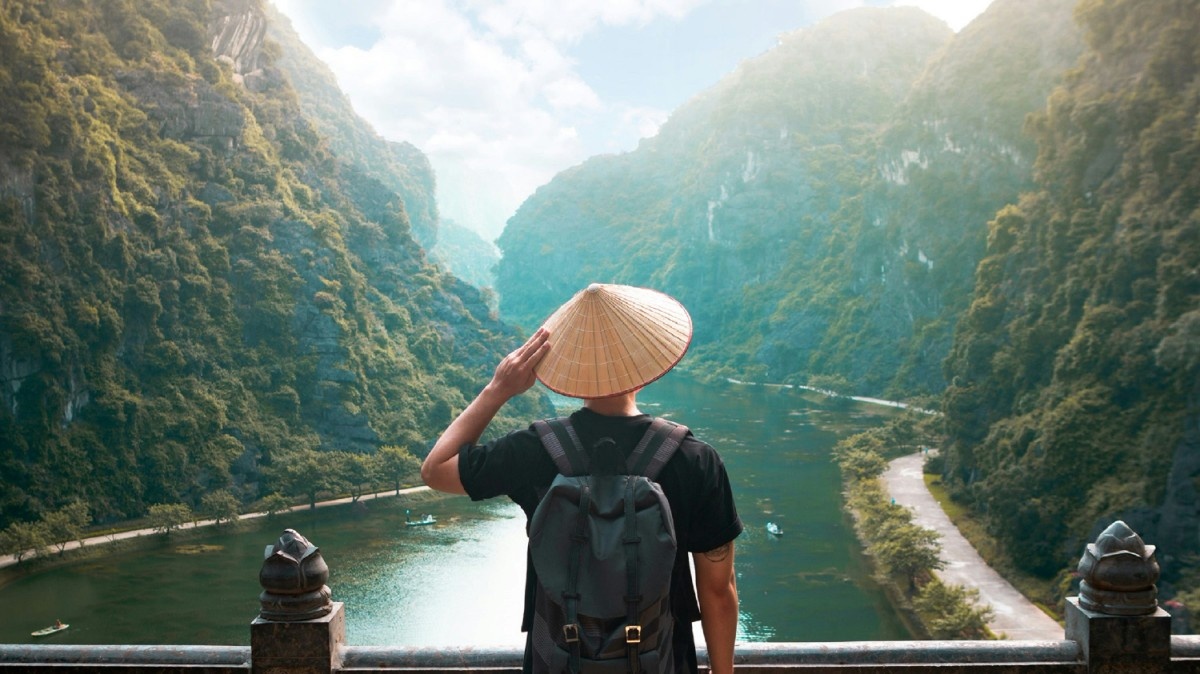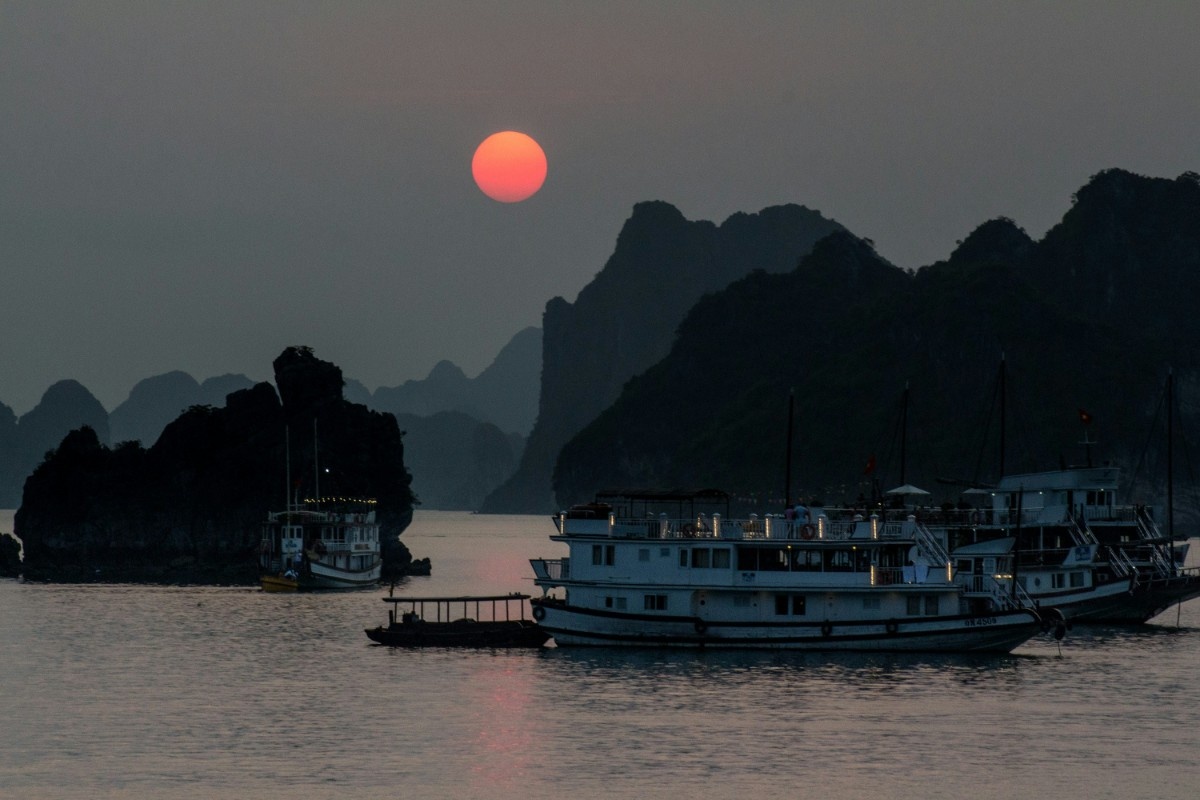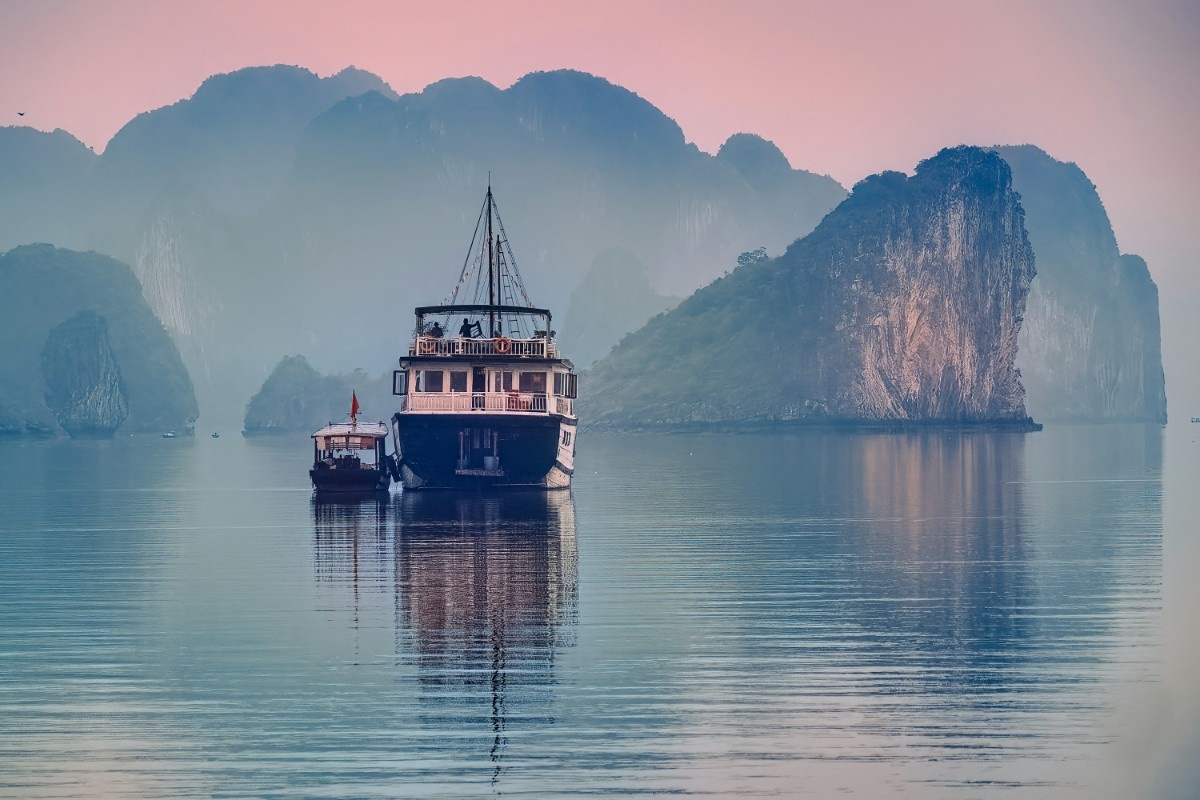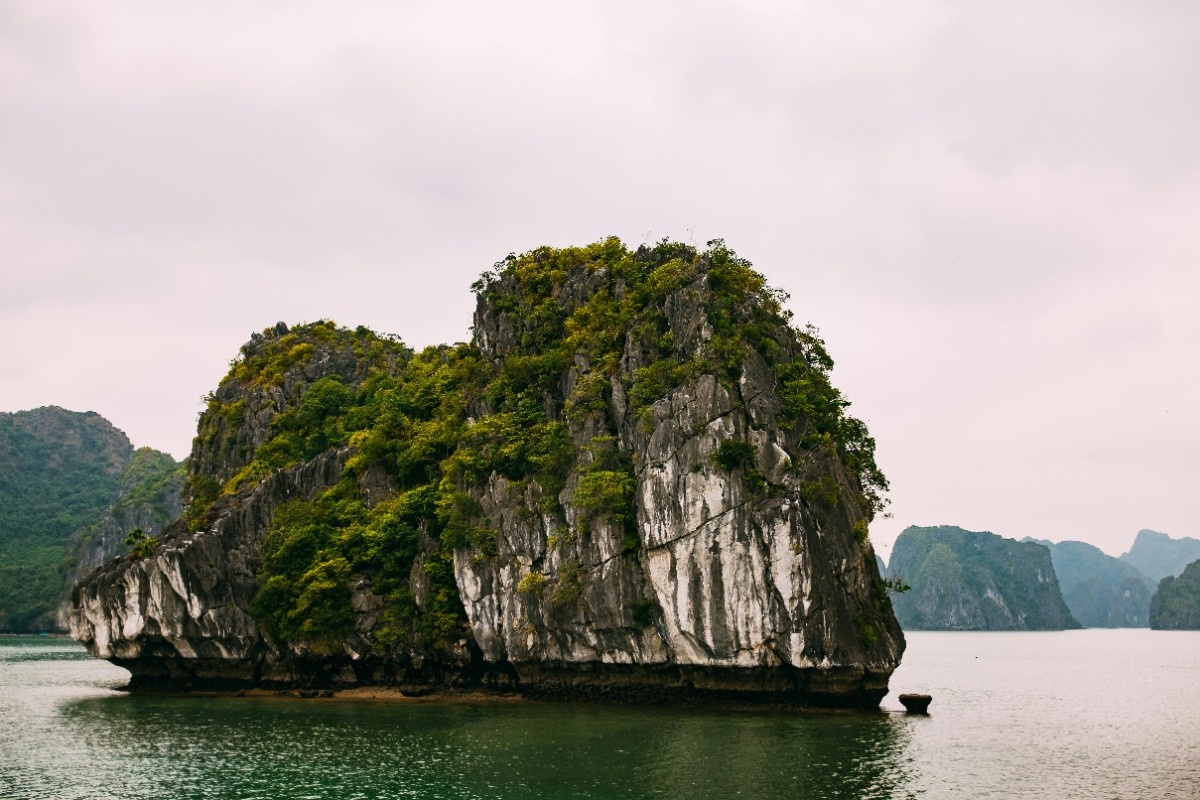Introduction to Ha Long Bay
Overview of Ha Long Bay
Ha Long Bay, a UNESCO World Heritage Site, is a breathtaking natural wonder situated in the Quang Ninh Province of Vietnam. This iconic bay is renowned for its sparkling emerald waters and thousands of towering limestone karsts and islets, each adorned with lush jungle vegetation. The name "Ha Long" translates to "descending dragon," a moniker that originated from an ancient legend telling of a dragon descending into the bay, creating the unique landscape we see today. Spanning over 1,500 square kilometres, Ha Long Bay is home to around 1,960 islands and islets, the majority of which remain uninhabited and untouched by human influence. The serene beauty and geological significance of Ha Long Bay attract millions of visitors each year, solidifying its position as one of Vietnam's most popular tourist destinations.
Ecological Importance
Beyond its visual appeal, Ha Long Bay plays a crucial role in the region's biodiversity, housing numerous ecosystems, including tropical evergreen biosystem, oceanic and sea shore biosystem, and submerged ecosystems. These diverse habitats support a wide array of plant and animal life, making Ha Long Bay a haven for nature enthusiasts and researchers alike. The bay's tropical evergreen forests are home to rare medicinal plants, while its waters boast an estimated 1,000 species of marine life, including over 160 species of coral and 200 species of fish. The interconnectedness of these ecosystems is essential to the overall health and resilience of Ha Long Bay, emphasising the importance of conservation efforts to protect this natural treasure.
Cultural and Historical Significance
In addition to its ecological importance, Ha Long Bay holds great cultural and historical significance for the people of Vietnam. The bay has long been a source of inspiration for Vietnamese folklore, art, and literature, with numerous legends and stories associated with its stunning landscape. These tales, such as the legend of the descending dragon, have become an integral part of Vietnamese culture and identity, often depicted in traditional art forms. Ha Long Bay has also played a vital role in Vietnam's history, serving as a hideout for revolutionaries during the country's struggle for independence and as a strategic location for the North Vietnamese Army during the Vietnam War. Today, the bay stands as a symbol of Vietnam's natural and cultural heritage, drawing visitors from around the globe to experience its timeless beauty and rich history.
Geology and Formation of Ha Long Bay
Ancient Limestone Formation
The formation of Ha Long Bay's unique landscape dates back millions of years, with the limestone karsts and islets being the result of complex geological processes. The bay's bedrock is composed mainly of limestone, which formed during the Carboniferous and Permian periods, approximately 300 to 250 million years ago. This limestone was originally deposited in shallow marine environments, accumulating over time to create thick layers of carbonate rock. As the Earth's crust shifted and changed, these limestone formations underwent extensive tectonic uplift, exposing them to the elements and setting the stage for the development of Ha Long Bay's iconic karsts.
Karstification Process
The primary mechanism responsible for shaping Ha Long Bay's limestone karsts is a process called karstification. This process involves the dissolution of soluble rocks, such as limestone, by slightly acidic rainwater. As rainwater seeps into cracks and fissures in the limestone, it gradually dissolves the rock, creating an intricate network of caves, sinkholes, and underground drainage systems. Over millions of years, the continued dissolution of the limestone, combined with the effects of wind and wave erosion, has sculpted the towering karsts and islets that characterise Ha Long Bay. The varying heights and shapes of these formations are a testament to the complex interplay of geological processes that have taken place over time.
Notable Karsts and Geological Features
Some of the most notable karsts in Ha Long Bay include Dau Go, Thien Cung, and Sung Sot, each with its own unique features and geological history. Dau Go, also known as the "Cave of Wonders," is a massive limestone cave system featuring intricate stalactite and stalagmite formations. Thien Cung, or the "Heavenly Palace Cave," is renowned for its stunning interior, with vaulted ceilings and delicate rock formations. Sung Sot, which translates to "Surprise Cave," is a vast cavern with multiple chambers, each showcasing the incredible geological processes that have shaped Ha Long Bay over millions of years. These remarkable karsts and caves serve as a testament to the power and beauty of nature, offering visitors a glimpse into the Earth's ancient past.
Ongoing Geological Changes
While the formation of Ha Long Bay's limestone karsts and islets dates back millions of years, the landscape continues to evolve and change even today. The ongoing processes of erosion and dissolution, coupled with the effects of climate change and rising sea levels, are constantly reshaping the bay's features. As a result, Ha Long Bay stands as a living museum of Earth's geological past and a reminder of the dynamic nature of our planet's landscapes. By studying and understanding the geological processes that have shaped Ha Long Bay, we can gain valuable insights into the Earth's history and the profound impact of time on the natural world around us.
Biodiversity and Ecosystems
Diverse Habitat Types
Ha Long Bay is a remarkable haven for a diverse array of flora and fauna, thanks to its unique ecosystem that comprises numerous habitat types. These habitats include tropical evergreen forests, mangroves, coral reefs, and seagrass beds, each supporting a wide variety of plant and animal species. The limestone karsts and islands that rise from the bay's emerald waters are cloaked in dense tropical evergreen forests, which are home to an abundance of plant life, such as ferns, orchids, and rare medicinal plants. These forests also provide shelter for various wildlife species, including langurs, macaques, and numerous bird species. The mangrove forests that fringe the bay play a vital role in maintaining the health of the marine ecosystem, acting as nurseries for fish and shellfish while also protecting the coastline from erosion and storm surges.
Vibrant Marine Life
The waters of Ha Long Bay are equally diverse, supporting an estimated 1,000 species of marine life. The bay's underwater world is a kaleidoscope of colours, with over 160 species of coral creating vibrant reefs that teem with life. These reefs provide a home for an astounding 200 species of fish, as well as a wide variety of molluscs and crustaceans. The coral reefs of Ha Long Bay are not only visually stunning but also play a crucial role in the bay's ecosystem, acting as a source of food and shelter for countless marine organisms. In addition to the coral reefs, the bay's seagrass beds are another essential component of the marine ecosystem. These underwater meadows provide a vital source of nutrients for numerous species, including the critically endangered dugong, a gentle marine mammal that relies on seagrass for its survival.
Ecological Interconnectedness
The various habitats found within Ha Long Bay are intricately interconnected, with each playing a vital role in the overall health and resilience of the ecosystem. For example, the mangrove forests help to filter pollutants and sediments from the water, ensuring that the bay's coral reefs and seagrass beds remain healthy and productive. In turn, these underwater habitats provide a source of food and shelter for the diverse array of marine life that calls Ha Long Bay home. The tropical evergreen forests that cloak the limestone karsts also contribute to the bay's ecosystem, helping to regulate the local climate and provide a source of nutrients for the marine environment. This ecological interconnectedness highlights the importance of preserving and protecting all of Ha Long Bay's habitats, as the loss of one could have cascading effects on the entire ecosystem.
Conservation Efforts
Recognising the importance of Ha Long Bay's biodiversity and ecosystems, the Vietnamese government and local authorities have implemented various conservation measures to protect this natural wonder. These efforts include the establishment of protected areas, such as the Cat Ba National Park, which encompasses a portion of Ha Long Bay and its surrounding forests. Additionally, regulations have been put in place to limit the impact of tourism on the bay's delicate ecosystems, such as restricting the number of visitors to certain areas and implementing eco-friendly practices in the tourism industry. Conservation organisations and local communities are also working together to raise awareness about the importance of preserving Ha Long Bay's biodiversity and promoting sustainable practices. By prioritising the protection of this incredible natural heritage, we can ensure that the diverse habitats and species found within Ha Long Bay continue to thrive for generations to come.
Climate and Weather in Ha Long Bay
Tropical Monsoon Climate
Ha Long Bay experiences a tropical monsoon climate, characterised by distinct wet and dry seasons. The bay's weather patterns are heavily influenced by the northeast monsoon, which brings cool, dry air from November to April, and the southwest monsoon, which brings warm, humid air and heavy rainfall from May to October. The interaction between these two monsoon systems creates a unique climate that shapes the bay's landscapes and ecosystems. During the dry season, Ha Long Bay experiences mild temperatures and low humidity, with average temperatures ranging from 15°C to 25°C. This pleasant weather makes it an ideal time for tourists to visit the bay and enjoy activities such as cruises, kayaking, and hiking.
Rainy Season Characteristics
The rainy season in Ha Long Bay typically lasts from May to September, with the heaviest rainfall occurring in July and August. During this time, the bay receives an average of 1,800 to 2,000 millimetres of rain, which can sometimes result in flooding and landslides in the surrounding areas. Despite the heavy rainfall, the bay's towering limestone karsts and islets create a stunning visual contrast against the misty, grey skies, offering visitors a unique and atmospheric experience. The rainy season also brings with it higher temperatures and humidity levels, with average temperatures ranging from 25°C to 35°C. While the rainy season may not be the most popular time to visit Ha Long Bay, it can be an excellent opportunity for travellers who prefer a more tranquil experience, as there are fewer crowds and the bay takes on a mysterious, ethereal quality.
Impact of Weather on Tourism
The weather in Ha Long Bay plays a significant role in shaping the tourism industry, with the peak travel season coinciding with the dry months of November to April. During this time, visitors can enjoy warm, sunny weather and clear skies, making it perfect for outdoor activities such as swimming, kayaking, and rock climbing. The pleasant weather also makes it an ideal time for Ha Long Bay cruises, allowing visitors to fully appreciate the bay's stunning landscapes and vibrant sunsets. However, the rainy season should not be overlooked by travellers, as it offers a unique and enchanting experience. The misty, ethereal atmosphere created by the rain and fog can add a sense of mystery and romance to Ha Long Bay, making it a perfect destination for couples or those seeking a more contemplative experience.
Climate Change Concerns
Like many coastal regions around the world, Ha Long Bay is vulnerable to the impacts of climate change. Rising sea levels, increased storm intensity, and changes in rainfall patterns all pose significant threats to the bay's delicate ecosystems and the communities that depend on them. Climate change could lead to the inundation of low-lying areas, erosion of the bay's limestone karsts, and the loss of important habitats such as mangroves and coral reefs. Additionally, changes in the bay's climate could have significant impacts on the tourism industry, which is a vital source of income for the region. To mitigate these risks, the Vietnamese government and local authorities are working to implement climate change adaptation and mitigation strategies, such as promoting sustainable tourism practices, protecting and restoring important habitats, and raising awareness about the impacts of climate change. By taking proactive steps to address these challenges, we can help ensure that Ha Long Bay remains a stunning natural wonder for generations to come, while also supporting the resilience of the communities and ecosystems that call this remarkable place home.
Cultural and Historical Significance
Legends and Folklore
Ha Long Bay holds a special place in Vietnamese culture, with its breathtaking landscapes and unique geological features inspiring countless legends and folklore. One of the most famous legends associated with the bay is the tale of the descending dragon. According to this ancient story, the Vietnamese people were besieged by invaders from the north. The Jade Emperor, who ruled over the heavens, sent the Mother Dragon and her children to aid the Vietnamese in their struggle. As the dragons descended upon the earth, they spat out jewels and jade, which transformed into the thousands of islands and islets that now dot Ha Long Bay. The dragons then remained in the bay, with the Mother Dragon laying down in Ha Long and her children settling in Bai Tu Long Bay, to protect the Vietnamese people from future threats. This legend not only explains the formation of the bay's unique landscape but also highlights the deep connection between the Vietnamese people and the sea.
Inspiration for Art and Literature
The stunning beauty of Ha Long Bay has long served as a source of inspiration for Vietnamese artists and writers. The bay's towering limestone karsts, emerald waters, and misty horizons have been depicted in countless paintings, poems, and stories throughout history. One of the most famous works inspired by Ha Long Bay is the poem "Cảnh Hạ Long" (The Scenery of Ha Long) by the renowned Vietnamese poet Nguyễn Trãi. In this poem, Nguyễn Trãi describes the bay's ethereal beauty and its ability to evoke a sense of wonder and tranquillity in those who behold it. The bay has also been featured in numerous Vietnamese films and television shows, showcasing its stunning landscapes and rich cultural heritage to audiences around the world. By serving as a constant source of inspiration for artists and writers, Ha Long Bay has become an integral part of Vietnam's cultural identity, embodying the country's deep connection to nature and its rich artistic traditions.
Historical Significance
In addition to its cultural importance, Ha Long Bay has also played a significant role in Vietnam's history. During the country's struggle for independence in the early 20th century, the bay's numerous caves and hidden coves served as hideouts for Vietnamese revolutionaries. These secret bases provided a safe haven for the rebels to plan their strategies and gather their strength, away from the watchful eyes of the French colonial authorities. Later, during the Vietnam War, Ha Long Bay once again proved to be a strategic location. The North Vietnamese Army used the bay's islands and caves as supply bases and hiding spots, taking advantage of the area's natural defences to evade American bombing raids. The bay's role in these pivotal moments of Vietnamese history has cemented its place as a symbol of the country's resilience and determination in the face of adversity.
Preservation and Recognition
Recognising the immense cultural and historical value of Ha Long Bay, the Vietnamese government has taken steps to preserve and protect this natural wonder. In 1994, the bay was designated as a UNESCO World Heritage Site, acknowledging its outstanding universal value and its importance to the world's natural and cultural heritage. This designation has helped to raise awareness about the need to conserve the bay's delicate ecosystems and unique geological features, as well as its rich cultural and historical legacy. Today, Ha Long Bay is not only a popular tourist destination but also a source of great pride for the Vietnamese people. It stands as a testament to the country's stunning natural beauty, its vibrant cultural traditions, and its remarkable history, reminding us of the deep and enduring connection between the Vietnamese people and the sea.
Tourism and Activities in Ha Long Bay
Cruises and Boat Tours
One of the most popular ways to experience the breathtaking beauty of Ha Long Bay is by embarking on a cruise or boat tour. These cruises range from short day trips to multi-day excursions, catering to various preferences and budgets. Visitors can choose from a wide selection of boats, including traditional wooden junks, modern luxury cruises, and intimate sailboats. As they navigate through the bay's emerald waters, passengers are treated to stunning views of the towering limestone karsts, hidden caves, and picturesque floating villages. Many Ha Long Bay cruises also offer a range of on-board activities, such as cooking classes, tai chi sessions, and evening entertainment, ensuring that visitors have a truly immersive and memorable experience.
Kayaking and Water Sports
For those seeking a more active and adventurous way to explore Ha Long Bay, kayaking and other water sports are excellent options. Paddling through the bay's tranquil waters in a kayak allows visitors to get up close and personal with the towering limestone cliffs and hidden grottoes. Many tour operators offer guided kayaking excursions, which take participants to some of the bay's most stunning and secluded spots, such as the Luon Cave and the Three Peaches islet. In addition to kayaking, visitors can also enjoy other water activities, such as swimming, snorkelling, and stand-up paddleboarding, in the calm and clear waters of the bay.
Hiking and Cave Exploration
While Ha Long Bay is primarily known for its stunning seascapes, the region also offers excellent opportunities for hiking and cave exploration. The bay's numerous islands and islets are home to a network of hiking trails that wind through lush forests and up steep limestone cliffs, rewarding adventurous travellers with panoramic views of the surrounding landscape. Some of the most popular hiking destinations in Ha Long Bay include Cat Ba Island, which boasts a challenging trek to the summit of Ngu Lam Peak, and Titop Island, which offers a short but steep climb to a lookout point with breathtaking vistas of the bay. In addition to hiking, visitors can also explore some of the bay's fascinating caves, such as Sung Sot Cave and Dau Go Cave, which feature intricate rock formations and hidden chambers that showcase the region's unique geology.
Cultural Experiences and Floating Villages
No visit to Ha Long Bay would be complete without immersing oneself in the region's rich cultural heritage. One of the best ways to do this is by visiting one of the bay's traditional floating villages, such as Cua Van or Vung Vieng. These villages, which are home to generations of fishing families, offer a glimpse into the unique way of life of the people who call Ha Long Bay home. Visitors can take a boat tour through the villages, observing the daily activities of the residents and learning about their customs and traditions. Some tours also include visits to local schools or community centres, providing an opportunity for travellers to interact with the villagers and gain a deeper understanding of their culture. In addition to the floating villages, visitors can also explore other cultural attractions in the region, such as the Quang Ninh Museum, which showcases the area's history and cultural heritage, and the Long Tien Pagoda, a beautiful Buddhist temple perched atop a limestone cliff overlooking the bay.
Conservation and Environmental Challenges
Water Pollution and Waste Management
Despite its status as a UNESCO World Heritage Site, Ha Long Bay faces significant environmental challenges, particularly in terms of water pollution and waste management. The rapid growth of tourism in the region has put immense pressure on the bay's delicate ecosystem, with the increased number of boats and hotels contributing to the deterioration of water quality. Many of these vessels and establishments lack proper waste management systems, leading to the direct discharge of sewage, garbage, and other pollutants into the bay's waters. This pollution not only affects the aesthetic beauty of Ha Long Bay but also poses a serious threat to the diverse marine life that calls the bay home. The accumulation of plastic waste, in particular, has become a major concern, as it can entangle or be ingested by marine animals, causing injury, starvation, and even death.
Unsustainable Fishing Practices
Another significant environmental challenge facing Ha Long Bay is the issue of unsustainable fishing practices. The bay's waters are home to a rich variety of fish, molluscs, and crustaceans, which have long been an essential source of food and livelihood for the local communities. However, as the demand for seafood has grown, both locally and internationally, many fishermen have resorted to using destructive fishing methods, such as dynamite fishing and the use of fine-mesh nets, to maximise their catches. These practices not only damage the delicate coral reefs and seagrass beds that serve as critical habitats for marine life but also lead to the indiscriminate killing of juvenile fish and non-target species. Over time, these unsustainable fishing practices can lead to the depletion of fish stocks, upsetting the delicate balance of the bay's ecosystem and threatening the long-term viability of the fishing industry.
Impacts of Tourism Infrastructure Development
The rapid development of tourism infrastructure in and around Ha Long Bay has also taken a toll on the region's environment. As more and more hotels, resorts, and restaurants are built to accommodate the growing number of visitors, natural habitats are being destroyed or fragmented, and the bay's unique landscape is being irreversibly altered. The construction of these facilities often involves the clearing of forests, the filling in of wetlands, and the modification of coastlines, all of which can have devastating consequences for the local flora and fauna. In some cases, entire islands have been levelled or reshaped to make way for tourism developments, permanently changing the character of Ha Long Bay. The increased human presence and activity associated with these developments also contribute to noise pollution, light pollution, and the disturbance of wildlife, further exacerbating the environmental pressures on the bay.
Climate Change and Rising Sea Levels
In addition to the localised environmental challenges mentioned above, Ha Long Bay is also vulnerable to the global threat of climate change and rising sea levels. As atmospheric temperatures continue to rise due to the accumulation of greenhouse gases, the world's oceans are absorbing more heat and expanding, causing sea levels to rise at an accelerating rate. For Ha Long Bay, this means that many of its low-lying islands, beaches, and coastal communities are at risk of being submerged or eroded in the coming decades. The intrusion of saltwater into freshwater aquifers and agricultural lands could also pose serious challenges for the region's food and water security. Moreover, climate change is expected to intensify the frequency and severity of extreme weather events, such as typhoons and storm surges, which could cause significant damage to the bay's infrastructure and ecosystems. Addressing these climate-related threats will require a concerted effort at both the local and global levels, involving the adoption of sustainable development practices, the reduction of greenhouse gas emissions, and the implementation of effective adaptation and resilience strategies.
Conclusion and Future of Ha Long Bay
Balancing Conservation and Development
As Ha Long Bay continues to face a range of environmental challenges, it is clear that finding a balance between conservation and development will be crucial to ensuring the long-term sustainability of this natural wonder. While the growth of tourism has brought significant economic benefits to the region, it has also put immense pressure on the bay's delicate ecosystems and cultural heritage. To address these challenges, it is essential that all stakeholders, including government agencies, tourism operators, local communities, and visitors, work together to promote responsible and sustainable practices. This may involve implementing stricter regulations on waste management and water pollution, promoting eco-friendly tourism activities, and investing in the development of green infrastructure. By prioritising conservation and adopting a more sustainable approach to development, we can help to preserve the natural beauty and ecological integrity of Ha Long Bay for generations to come.
Empowering Local Communities
Another key aspect of ensuring a sustainable future for Ha Long Bay is empowering and engaging local communities in conservation and tourism efforts. For centuries, the people living in and around the bay have relied on its resources for their livelihoods and have developed a deep cultural and spiritual connection to this unique landscape. By involving these communities in decision-making processes, providing them with the necessary skills and resources, and ensuring that they benefit equitably from tourism revenues, we can create a more inclusive and resilient model of development. This may involve supporting community-based tourism initiatives, promoting traditional crafts and sustainable fishing practices, and investing in education and capacity-building programs. By empowering local communities to become stewards of their own natural and cultural heritage, we can help to foster a sense of pride and ownership in the preservation of Ha Long Bay.
Promoting Environmental Education and Awareness
Promoting environmental education and awareness among visitors and local communities alike is another critical step in securing a sustainable future for Ha Long Bay. By helping people to understand the ecological and cultural significance of this unique landscape, as well as the threats it faces, we can inspire them to adopt more responsible and environmentally conscious behaviours. This may involve developing educational programs and interpretive materials, organising clean-up campaigns and conservation projects, and encouraging visitors to make more sustainable choices in terms of transportation, accommodation, and activities. By fostering a greater appreciation for the natural world and a shared sense of responsibility for its protection, we can help to build a more informed and engaged citizenry that is committed to the long-term conservation of Ha Long Bay.
Embracing Sustainable Tourism Practices
Finally, embracing sustainable tourism practices will be essential to ensuring that Ha Long Bay remains a vibrant and resilient destination for generations to come. This may involve promoting low-impact activities, such as kayaking, hiking, and birdwatching, over more resource-intensive pursuits, such as motorised water sports and mass tourism. It may also involve encouraging the development of eco-friendly accommodations, such as green hotels and eco-lodges, that minimise their environmental footprint and support local conservation efforts. By adopting a more sustainable approach to tourism, we can help to reduce the pressure on the bay's ecosystems, while also providing visitors with a more authentic and meaningful travel experience. Ultimately, the future of Ha Long Bay will depend on our ability to strike a balance between the needs of nature, the aspirations of local communities, and the desires of visitors, and to work together towards a shared vision of sustainability and resilience.
Related Articles

Let us know you agree to cookies
We use marketing, analytical and functional cookies as well as similar technologies to give you the best experience. Third parties, including social media platforms, often place tracking cookies on our site to show you personalised adverts outside of our website.
We store your cookie preferences for two years and you can edit your preferences via ‘manage cookies’ or through the cookie policy at the bottom of every page. For more information, please see our cookie policy.
